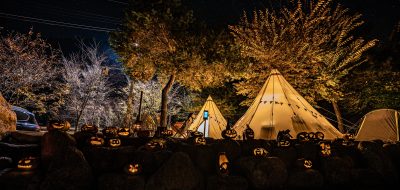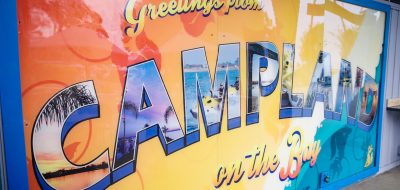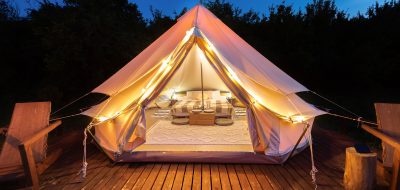
Last Saturday I wrote about the joys of boondocking–camping without hook-ups. Now we will look at how to find great boondocking spots–but not including Wal-Mart parking lots, RV rallies or “primitive” campgrounds such as those operated by the National Forest Service (NFS) or national and state parks, but rather what the Bureau of Land Management (BLM) and NFS refer to as “non-designated” or “dispersed” camping. This means that the campsites within a defined camping area, such as the BLM’s Long Term Visitor Areas [LTVA], state fish and game fishing access spots, and some Bureau of Reclamation areas, are not defined or have nice numbered campsite signs. They are, however, recognizable, since you can see where others have camped before. These spots are preferable to destroying plants or disturbing the area (site preparation can be hard work) to create a new camping spot.
The extreme of “dispersed” is what I call “coyote camping,” when you follow a BLM or NFS road (usually unpaved) until you find a suitable campsite in a non-defined camping area. These campsites are remote and isolated, with just a slim chance of having other RVs within sight or nearby, though in the large areas designated as LTVAs you can be as close or as far away from others as you want. You can find just about any type of campsite and any degree of privacy you want, but you have to look for it.

Desert/BLM Camping
Finding desert campsites is easier than finding forest sites. You can see:
- Long distances ahead to spot difficulties, poor road conditions, and turnarounds.
- The type of terrain you are heading for.
- Whether other campers are present.
- Whether the Victoria’s Secret models on their annual camping trip have taken all the good spots.
But let’s back up a step or two and start at the beginning. First, before you head out, find the BLM field office locations for where you plan to travel (www.blm.org/az or other two-letter state designation). If the field office is on your route, it should be the first stop. Here you will find maps (especially one that shows where the BLM land area is), locations of LTVAs, information and brochures on wildlife, geology, old mines, historic sites, or whatever your particular interest, and rangers that can direct you to dispersed camping areas.
One caveat, though, you will most likely obtain dispersed camping information only from rangers who actually go out and patrol their domain. Office help, docents, and volunteers (there are exceptions) usually do not have this information. Second, either head out to where a ranger suggests, or, if you didn’t manage to get any usable information, you will have to do your own field research.
If you have a few days or longer, one plan is to stay the first night in a campground and drive your tow/toad on a research mission. Check out the back roads (which is enjoyable in itself) until you find a spot you like. If you are just looking for an overnight spot while traveling, keep a look out for broad flat spaces just off the paved road–easier to find off two-lane roads—where you can either spend the night, or . . . take the first spot you come to and do your exploring from there. You won’t find much bothersome road noise from desert two-lane roads after dark.
Remember, the BLM land is your land. It is—literally–public land, belonging to you and every other American. You can camp and recreate anywhere on your land except where specifically prohibited. That means that there are signs or fences prohibiting entrance (maybe just to vehicles but not for hiking or biking), or if private property, signs and fences indicating that. Anywhere else, if you can get off the highway onto the road and get off the side of it to camp, it is fine and legal. Be aware, that even in coyote campsites, there is a two-week limit on camping—though you don’t have to register–then you have to move a minimum of twenty-five miles away from that spot.
When you are driving the unpaved roads looking for a spot, you need to look at the features from your rig’s standpoint:
- Is the surface solid enough to support your rig?
- Are there any depressions, rocks, humps, etc. that could damage your undercarriage or dump valves?
- Is the campsite you find large enough to turn around?
- Is the campsite level, or can you get level?Can you get far enough off the highway to diminish or escape road noise?
- Is there a killer view and lots of hills and washes to explore?
- Did you remember to load extra containers of water, peanut butter, and salad greens to last?
When you’ve answered these questions to your liking, go back and get your rig (and remember to plot the location on your GPS or make a note on your map–I mark mine on the campground guide map—so you can find it again the next time. Then kick back and enjoy coyote camping in the vast expanse of the magnificent desert.
Next Saturday, finding dispersed campsites in national and state forests and other public lands.





reverse number lookup
The when Someone said a weblog, Lets hope which it doesnt disappoint me up to this.
After all, I know it was my method to read, on that
the other hand I just thought youd have something interesting to convey.
All I hear is usually a few whining about something you could fix if you werent too
busy in lookup of attention.
Hanna
Because of your work, I work with former ,
Bob Difley
Don – True about the eastern states and finding national forests to boondock in. I have yet to find a state forest, however, that doesn’t allow boondocking, though I haven’t tried this in all states. I would be interested in anyone out there who knows of a state forest that does not allow camping/boondocking. You can also try lands managed by the Bureau of Reclamation, Army Corps of Engineers, municipal watersheds, and national or state wildlife reserves or refuges. Regarding your being asked to move by a policeman, that’s interesting. I’m glad you took the time to “straighten it out” since it is your right to camp on public land unless specifically prohibited by fences, signs, or other notifications. Public land is our land and can be used for legal recreational purposes and cannot be denied by policemen, camp hosts, or other self-appointed “authorities” who would deny these rights.
Don Nelson
I live in Maryland. There is not much public land in the East. The general maps showing the boundries of National Forests are drawn around scattered spots of land that is public, while often two-thirds of the land inside the boundries is in private ownership. You need a very detailed map showing ownership to avoid boondocking on private land. Another category of public land that might contain potential boondocking sites is state forests. Does anyone have a good list of states that permit boondocking on their state forests. And if they don’t permit it, why not? I expect some will raise the liability issue. If you get hurt on their land, is the owner liable? Is the federal government liable if you get hurt while boondocking on public land?
With more and more Forest Service campgrounds being turned over to concessionaires, I have a sneaky suspicion that many good boondocking are being lost so that campgrounds can make more money. Campground fees seem to go up as soon as the concessionaire moves in. Last year I was camping legally at a trailhead on Forest Service land when a policeman arrived to inform me that I had to leave because a campground host had conviced the policeman that I had to camp in a campground. I straightened it out the next day at the Forest Service office, but this illustrates my point.
Pingback: How to Find Great Boondocking Campsites Part III
Bob Difley
Probably would be more accurate if I logged in under my own name, rather than my wife Lynn’s. However, her opinions would be similar. Bob
Lynn Difley
Good information, Chris. There is a fine boondocking place south of Lake Havasu City that is mostly deserted mid-week but is a favorite of off-roaders on the weekends. Not a pleasant Saturday campground to commune with nature. Look for places that seem to have excessive use: debris and trash, lots of fire rings, ORV trails, etc. that are empty mid week and you can guess what it may be like on the weekends. Best chances, away from cities and towns. Thanks Chris
Chris
Word-of-Mouth also plays a big role in finding out about good boondocking sites. If you’re already at a boondocking site where there are several other campers nearby, they may tell you about general areas where boondocking is allowed. However, most people have “secret” sites, that they usually won’t give detailed directions to.
Some National Forest and BLM administrations are sympathetic to boondocking. Others are not.
In certain ranger districts of some National Forests, as well as some BLM land, nearly all the potential boondocking sites have been blocked off or posted closed with signs. There are sometimes virtually no places where an RV can park legally and undisturbed, especially for more than one night. These areas are sometimes but not always near cities, tourist areas, or the larger ski areas. The attitude can vary between ranger districts, even within a given National Forest. Often private campground owners, or the concessionaires who get money for running the Forest Service or BLM campgrounds, have exerted their influence to make sure that RVers will have to pay for a campsite anywhere in the area. In some of the popular areas, the boondocking sites will be all taken, or you will have to crowd next to several other campers.
Also be careful when choosing a site you’ll be at over the weekend – Some sites that are quiet and pristine mid-week, can become the regular scene of out-of-control, drunken, noisy parties on weekends. You might be by all yourself mid-week, only to be joined by a rowdy crowd over the weekend. This is especially true of areas near cities, or sites just outside of the smaller towns.
Then again, there are also National Forest and BLM lands where there are still enough boondocking sites so that some are almost always available. These are often the more remote areas, far from any major cities. Often, all you need to do is turn off the main highway, and drive up a forest service road a few miles, and there will be several sites. These can vary from just roadside pull-offs in a non-descript area, such as in blown-down trees or brush; to some really beautiful sites alongside a stream or with a beautiful view.
The suggestion about camping at a regular campground for a day, and scouting the area ahead of time, is good advice. It also is important to have some information about whether there are any boondocking sites in the general area, before going to that area.
Bob Difley
John – It depends on the kind of wash and the season. Gully washers causing flash floods seldom happen in the winter , but rather during the summer monsoon season. Wide washes without steep sides with short lengths do not build up the amount of runoff to create flash flooding. However, as always, keep an eye on the weather if you camp in a wash, especially if the wash collects the runoff from a broad area, where it may be raining a few miles away even though you are dry and sunny. Thanks for the comment.
Thanks Greg, I know it should have been .org but my fingers–and my brain–did the walking and landed on the wrong keys. Thanks for spotting the error and pointing it out.
Gary Meyer
Good ariticle, however I think the BLM site is http://www.blm.gov, not .org.
John Hilley
Make sure you don’t camp in a wash. A sudden rain storm can create a flood. Flooded washes can also prevent you getting back to a highway for a day or two.